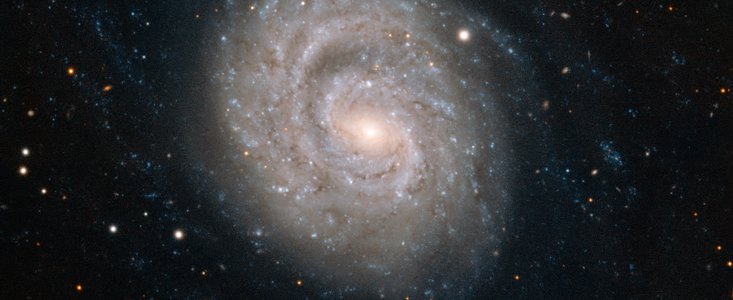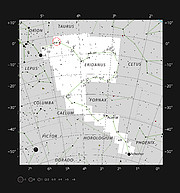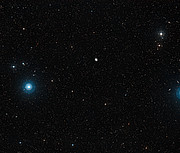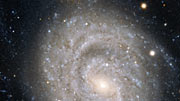Tisková zpráva
Krásná spirála ozdobená slábnoucí supernovou
20. března 2013
Na obloze najdete v souhvězdí Eridanus spirální galaxii NGC 1637, která se nachází asi 35 milionů světelných let od Země. V roce 1999 narušila jinak neměnný vzhled této galaxie poměrně jasná supernova. Astronomové studující dozvuky této exploze na observatoři Paranal v Chile pomocí dalekohledu ESO/VLT pořídili působivý snímek, na kterém je tato poměrně blízká galaxie zachycena v neobvyklých detailech. A vy si ji teď můžete prohlédnout.
Supernovy patří k nejničivějším jevům v přírodě. Doprovázejí smrt hvězd a mohou v krátkém okamžiku přezářit kombinované světlo miliard hvězd v celé mateřské galaxii.
V roce 1999 oznámili astronomové pracující na Lickově observatoři v Kalifornii objev nové supernovy v galaxii NGC 1637. Byla nalezena pomocí dalekohledu speciálně uzpůsobeného právě pro hledání těchto velmi důležitých kosmických objektů [1]. Aby jev mohl být potvrzen a studován detailněji, bylo potřeba provést řadu následných pozorování. Supernova dostala označení SN 1999em a byla velmi hojně sledována. Po explozi v roce 1999 vědci pečlivě monitorovali její jasnost a ukázalo se, že celá léta slábla jen pozvolna.
Hvězda, která explodovala jako supernova SN 1999em, byla před svou smrtí velmi hmotná, patrně více jak osmkrát hmotnější než Slunce. V samotném závěru života této hvězdy došlo ke kolapsu jejího jádra, což vyvolalo následnou kataklyzmatickou explozi [2].
Při pozorováních supernovy SN 1999em astronomové pořídili mnoho snímků tohoto objektu i pomocí dalekohledu VLT. Záběry byly následně zkombinovány, což nám poskytlo tento velmi čistý, ostrý a detailní pohled na mateřskou galaxii této supernovy – NGC 1637. Spirální struktura se na snímku projevuje velmi nápadným vzorem namodralých mladých hvězd uspořádaných do vláken, zářících oblaků plynu a zastiňujících pásů prachu.
Ačkoliv na první pohled vypadá galaxie NGC 1637 docela symetrická, narazíme u ní na řadu zajímavých vlastností. Tento typ galaxie astronomové klasifikují jako ‚nesouměrná spirála‘ (lopsided spiral galaxy): poměrně volně zavinuté spirální rameno vlevo nahoře se kolem jádra táhne mnohem dále než kompaktnější a kratší rameno vpravo dole, které navíc vypadá jako rozseknuté v půlce.
Kdekoliv na snímku je pohled posetý řadou výrazně bližších hvězd a naopak mnohem vzdálenějších galaxií, které náhodou leží ve stejném směru.
Poznámky
[1] Supernova byla objevena pomocí dalekohledu KAIT (Katzman Automatic Imaging Telescope), který pracuje na Lickově observatoři na hoře Mount Hamilton v Kalifornii.
[2] SN 1999em je takzvaná ‚core-collapse‘ supernova, tj. supernova s kolabujícím jádrem. Přesněji je klasifikována jako typ IIp, kde písmeno ‚p‘ značí anglický výraz ‚plateau‘, znamenající ‚plochý‘ či ‚rovný‘. V praxi to znamená, že supernova zůstává jasná po dlouhou dobu po hlavním maximu a její maximum je tedy ploché.
Další informace
ESO je nejvýznamnější mezivládní astronomická organizace Evropy a v současnosti nejproduktivnější pozemní astronomická observatoř. ESO podporuje celkem 15 členských zemí: Belgie, Brazílie, Česká republika, Dánsko, Finsko, Francie, Itálie, Německo, Nizozemsko, Portugalsko, Rakousko, Španělsko, Švédsko, Švýcarsko a Velká Británie. ESO uskutečňuje ambiciózní program zaměřený na návrh, konstrukci a úspěšný chod výkonných pozemních pozorovacích komplexů umožňujících astronomům dosáhnout významných vědeckých objevů. ESO také vedoucí úlohu při podpoře a organizaci spolupráce v astronomickém výzkumu. ESO provozuje tři unikátní pozorovací střediska světového významu nacházející se v Chile: La Silla, Paranal a Chajnantor. Na Observatoři Paranal provozuje Velmi velký teleskop (VLT), což je nejvyspělejší astronomická observatoř pro viditelnou oblast světla, a také dva další přehlídkové teleskopy. VISTA pracuje v infračervené části spektra a je největším přehlídkovým dalekohledem na světě, dalekohled VST (VLT Survey Telescope) je největším teleskopem navrženým k prohlídce oblohy výhradně ve viditelné části spektra. ESO je evropským partnerem revolučního astronomického teleskopu ALMA, největšího astronomického projektu současnosti. Pro viditelnou a blízkou infračervenou oblast ESO rovněž plánuje nový dalekohled E-ELT (European Extremely Large optical/near-infrared Telescope) s primárním zrcadlem o průměru 39 metrů, který se stane „největším okem do vesmíru“.
Odkazy
Kontakty
Richard Hook
ESO, La Silla, Paranal, E-ELT & Survey Telescopes Press Officer
Garching bei München, Germany
Tel.: +49 89 3200 6655
Mobil: +49 151 1537 3591
Email: rhook@eso.org
Anežka Srbljanović (press contact Česko)
ESO Science Outreach Network
a Astronomical Institute of Czech Academy of Sciences
Tel.: +420 323 620 116
Email: eson-czech@eso.org
O zprávě
| Tiskové zpráva č.: | eso1315cs |
| Jméno: | NGC 1637, Supernova |
| Typ: | Local Universe : Star : Evolutionary Stage : Supernova Local Universe : Galaxy : Type : Spiral |
| Facility: | Very Large Telescope |
| Instruments: | FORS1 |
Our use of Cookies
We use cookies that are essential for accessing our websites and using our services. We also use cookies to analyse, measure and improve our websites’ performance, to enable content sharing via social media and to display media content hosted on third-party platforms.
ESO Cookies Policy
The European Organisation for Astronomical Research in the Southern Hemisphere (ESO) is the pre-eminent intergovernmental science and technology organisation in astronomy. It carries out an ambitious programme focused on the design, construction and operation of powerful ground-based observing facilities for astronomy.
This Cookies Policy is intended to provide clarity by outlining the cookies used on the ESO public websites, their functions, the options you have for controlling them, and the ways you can contact us for additional details.
What are cookies?
Cookies are small pieces of data stored on your device by websites you visit. They serve various purposes, such as remembering login credentials and preferences and enhance your browsing experience.
Categories of cookies we use
Essential cookies (always active): These cookies are strictly necessary for the proper functioning of our website. Without these cookies, the website cannot operate correctly, and certain services, such as logging in or accessing secure areas, may not be available; because they are essential for the website’s operation, they cannot be disabled.
Functional Cookies: These cookies enhance your browsing experience by enabling additional features and personalization, such as remembering your preferences and settings. While not strictly necessary for the website to function, they improve usability and convenience; these cookies are only placed if you provide your consent.
Analytics cookies: These cookies collect information about how visitors interact with our website, such as which pages are visited most often and how users navigate the site. This data helps us improve website performance, optimize content, and enhance the user experience; these cookies are only placed if you provide your consent. We use the following analytics cookies.
Matomo Cookies:
This website uses Matomo (formerly Piwik), an open source software which enables the statistical analysis of website visits. Matomo uses cookies (text files) which are saved on your computer and which allow us to analyze how you use our website. The website user information generated by the cookies will only be saved on the servers of our IT Department. We use this information to analyze www.eso.org visits and to prepare reports on website activities. These data will not be disclosed to third parties.
On behalf of ESO, Matomo will use this information for the purpose of evaluating your use of the website, compiling reports on website activity and providing other services relating to website activity and internet usage.
Matomo cookies settings:
Additional Third-party cookies on ESO websites: some of our pages display content from external providers, e.g. YouTube.
Such third-party services are outside of ESO control and may, at any time, change their terms of service, use of cookies, etc.
YouTube: Some videos on the ESO website are embedded from ESO’s official YouTube channel. We have enabled YouTube’s privacy-enhanced mode, meaning that no cookies are set unless the user actively clicks on the video to play it. Additionally, in this mode, YouTube does not store any personally identifiable cookie data for embedded video playbacks. For more details, please refer to YouTube’s embedding videos information page.
Cookies can also be classified based on the following elements.
Regarding the domain, there are:
- First-party cookies, set by the website you are currently visiting. They are stored by the same domain that you are browsing and are used to enhance your experience on that site;
- Third-party cookies, set by a domain other than the one you are currently visiting.
As for their duration, cookies can be:
- Browser-session cookies, which are deleted when the user closes the browser;
- Stored cookies, which stay on the user's device for a predetermined period of time.
How to manage cookies
Cookie settings: You can modify your cookie choices for the ESO webpages at any time by clicking on the link Cookie settings at the bottom of any page.
In your browser: If you wish to delete cookies or instruct your browser to delete or block cookies by default, please visit the help pages of your browser:
Please be aware that if you delete or decline cookies, certain functionalities of our website may be not be available and your browsing experience may be affected.
You can set most browsers to prevent any cookies being placed on your device, but you may then have to manually adjust some preferences every time you visit a site/page. And some services and functionalities may not work properly at all (e.g. profile logging-in, shop check out).
Updates to the ESO Cookies Policy
The ESO Cookies Policy may be subject to future updates, which will be made available on this page.
Additional information
For any queries related to cookies, please contact: pdprATesoDOTorg.
As ESO public webpages are managed by our Department of Communication, your questions will be dealt with the support of the said Department.






